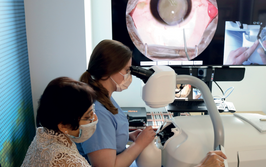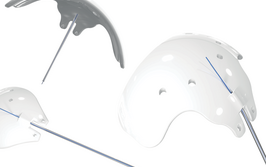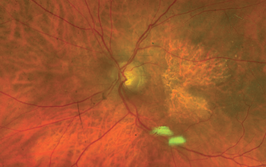
A Refractive Outlook for All
A focus on refractive outcomes might start at the top, but it shouldn’t end there
As ophthalmologists, we like to consider our surgical skill as the essential component in achieving great outcomes and high patient satisfaction after cataract surgery. But without a team of people gathering information and helping to educate patients along the way, building a successful refractive cataract surgery practice would not be possible.
My practice, Parkhurst NuVision, is centered on a refractive philosophy that permeates through every position – from the lead surgeon to the call center. Simply put, we believe that everyone ought to have the opportunity to see their best without being dependent on prosthetic eyewear.
Every year, we shut down our clinic for a day to talk about this philosophy. We share five-star reviews and celebrate successes with the whole staff. We’ve also started the Parkhurst NuVision Eye2Eye Global Initiative, which is similar to the Toms Shoes’ corporate responsibility model. For every patient who undergoes refractive surgery with us, we fund an operation through the Himalayan Cataract Project or charitable work elsewhere around the world. Our team members are incredibly excited and motivated to know they are not only making an impact to the patient in front of them, but also helping to cure a blind person elsewhere in the world.
The start of the journey
We are an optometric referral practice, and our patients’ education on cataract surgery and IOL options begins well before they walk through our doors. Typically,an optometrist who already has a relationship with the patient has started the conversation by explaining: “Some of the procedures you’re going to hear about are fully covered by insurance. Others are partially covered, but there might be a few thousand dollars on top of what insurance pays. The surgery center is going to discuss all your options with you.”
To streamline the education process, we have implemented a new QR code communication tool, available from Ocular Innovations. Our referring optometrists have business cards with a QR code that links to our practice. All the doctor has to do is say, “I’m going to refer you to Dr Parkhurst. You can open up your phone camera and scan this QR code.” The patient is then automatically sent a series of short custom videos created by our team (Figure 1). Not only is this an efficient way to ensure patients consistently get critical information in advance, but it also conveys a high-tech impression for both us and the referring practice.

Figure 1. Using QR scanning, referring optometrists are able to easily direct patients to short educational videos created by the practice.
First contact
We have a call center team that receives all phone and website inquiries, and proactively reaches out to patients whose optometrists have faxed us a referral form. The physical layout of our office allows our entire team to be connected through a central hallway, so the call center team is not detached from the rest of the practice. That way, if a patient has a question that needs to be answered by a doctor, the phone agent can walk down the hall and grab a doctor to resolve the issue quickly.
For many cataract patients, this initial contact is brief. They already know that they have a cataract, they need surgery, and will have a consultation with us. But if they bring up specific procedures or technologies, the call center staff will tell them, “We actually perform eight different modern treatments. One of the reasons you should come to see us is because we’re going to do a number of diagnostic tests. You’ll meet with the doctor and they’ll help you decide which of the different options is the best fit for your eyes.”
The in-office experience
When a patient walks through the door at our practice, they are greeted by someone who’s paying attention to them. Because we have the call center team handling calls in the back, the front desk receptionist’s job is strictly to welcome patients.
The front desk then hands the patient to our “ophthalmic navigators” – we prefer using this term over “technician” because their job is to navigate patients through the diagnostic work-up of their eyes. The navigator has been trained not only to perform the relevant tests, but also to show the patient the results and, in the process, give them a mini anatomy lesson. This is important because invariably, patients think a cataract is something like a pterygium — a growth or film over the eye. If patients think a cataract is external, they don’t understand why after surgery they would need an implant, let alone a premium lens. Therefore, the navigator’s role is essential in helping the patient understand the problem, before we start discussing the solution.
Weighing up the options
The next person the patient sees is usually one of my in-house optometrists, all of whom have completed a residency in anterior segment and refractive surgery. They continue the process of educating patients on what a cataract is and what types of IOLs we might be considering. Part of that process is gathering information about the patient’s profession, hobbies, and how they tend to use their eyes.
Assessment of the patient’s preexisting refractive error is a major factor in our decision making. A myope who removes his glasses to read has a very different life experience than a hyperope, high myope, or someone wearing progressive spectacles or multifocal contact lenses — and we need to recognize that in making IOL and refractive target choices. Throughout this process, the navigator and the optometrist are searching for information that will help them narrow down the list of IOL possibilities for that patient, so that we can present just a couple of options.

Presenting the choice
Before choosing from our wide range of refractive IOLs, we ask ourselves a series of questions:
- Is there something besides cataract, for example epiretinal membrane or macular degeneration, that will affect this patient’s visual potential?
- Does this patient have so much astigmatism that we need to use a toric IOL to correct it?
- Which distance is more important to the patient’s daily life – near or intermediate?
- Do they need a high add power for near activities?
For patients with other complicating factors, I often suggest that we either maximize their distance vision or their near vision with a monofocal platform. For patients without significant ocular comorbidities, and who want more spectacle independence, we now have two great options that are both suitable depending on the desires of the patient. The TECNIS Symfony (Johnson & Johnson Vision) EDoF platform offers a continuous range of vision in all lighting conditions, although patients may not be able to do fine or sustained near tasks without reading glasses. ,I sometimes consider a “personalized vision” approach, in which we combine two different IOLs, such as an EDoF in the dominant eye and a mid-add multifocal in the nondominant eye, to achieve specific goals for the patient. In other instances, we consider the new trifocal PanOptix (Alcon), which reaches distance, intermediate, and near targets. In addition to these already FDA approved IOLs, we are also clinical investigators for a small aperture IOL (IC-8, AcuFocus), and a new accommodating IOL (SC-9, CORD LLC), so those are also potential choices, depending on the patient’s goals and suitability for enrollment.
Closing the loop
The patient counselor is the last step of the journey, helping the patient by reviewing logistics, going over insurance coverage, and scheduling appointments for surgery, as well as postoperative follow-up. They also use simple tools to demonstrate what the expected outcome is for the patient, for each of the different IOL options presented by the doctor. This helps to set expectations and confirms that the patient has understood the difference between the available treatment choices.
After the consultation, we always communicate back to the optometrist who referred the patient, letting them know which type of surgery the patient will be having, and when they can expect to see them for postoperative care.
With this process, our entire team is involved in educating patients, navigating their choices, and helping us continue to build a strong refractive cataract practice.
Medical Director of Parkhurst NuVision in San Antonio, Texas, USA. He serves on the Medical Advisory Board for Ocular Innovations, Inc. He is an investigator for CORD and AcuFocus, and a consultant for J&J and Alcon.













